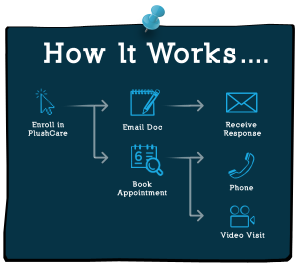Does your mobile phone provide better quality than a typical webcam? I'll test some virtual webcam software for mobile.
The doctor is in with WebRTC
 A visiting friend from Canada over the holidays came down with a nasty looking skin infection. With no US medical insurance, this meant a trip to a nearby urgent care clinic where they would likely be nailed ~$215 (the US national average). Plus we’d have to drive there, pay to park, fill out little forms with important information like where your father was born and then patiently wait to see at best a nurse practitioner. Hours wasted and money spent. A bit of Googling saved the day.
A visiting friend from Canada over the holidays came down with a nasty looking skin infection. With no US medical insurance, this meant a trip to a nearby urgent care clinic where they would likely be nailed ~$215 (the US national average). Plus we’d have to drive there, pay to park, fill out little forms with important information like where your father was born and then patiently wait to see at best a nurse practitioner. Hours wasted and money spent. A bit of Googling saved the day.
Meet the Uber of medical care, meet PlushCare. For a mere $45, you can book an appointment with a top rated doctor who at the appointed time will video in to you and provide a consultation. Easy booking, easy payment, easy access and high quality service. And all the video magic is done using WebRTC and everything is online.
Indeed for my friend, on that Saturday morning a Stanford educated doctor promptly appeared at the appointment hour, was polite, generous with their time, through in their questioning, provided a confident diagnosis and promptly issued a needed Rx to a nearby pharmacy. All without a lot of travel or complexity. I was sold. My friend spent the remainder of the weekend telling his Canadian friends America wasn’t as scary as the news was reporting.
Ryan McQuaid, a co-founder of PlushCare, agreed to speak with me and it was tough to try an confine my questioning to the world of WebRTC. WebRTC is but a small piece of the PlushCare application, but it’s the enabling piece. As a real life provider, PlushCare is in a unique position as to the realities of WebRTC. So I hit him with all the tough questions.
Does video matter? Yes, but the surprise answer is that it matters mostly to the doctor. Doctors, it turns out, like to see how you respond to their questions and are looking for facial clues as to whether to ask more questions. Florida laws by the way require remote medical consultations to have a video element. Unfortunately the low resolution video (and keeping steady) affect the viability of video for a skin type diagnosis (my friend sent in still photos from their mobile camera).
Does forcing the user to use Chrome or Firefox a problem? No. There you have it folks a real life answer from a real provider. So stop yapping about this as a problem. Another surprise. A large % of PlushCare users wouldn’t define themselves as “techies” and in fact are just normal every day folks with a medical issue they want handled in an affordable and convenient manner.
Are people put off using the technology? You know the correct answer is NO but you silently have thought up 257 reasons why people won’t like the technology because you’re a bah humbug person. But the real life usage wins, normal every day people have embraced the format of PlushCare’s model including the WebRTC element. So yes, even Grandma can figure this out.
How much medical work can be done remotely? Turns out about 70% of everyday medical conditions can be dealt with remotely. PlushCare has partnered with local labs who can provide walk in routing testing (for those requirements). While PlushCare is great for everyday illnesses, they already starting to see repeat customers asking for a specific physician. Clearly if you’re cut your finger off with an axe, you’re probably gonna need to be there physically (with your finger) and lucky for all of us AT&T is now supporting E911 with their WebRTC offering (don’t get me started).
How they’d do it? Using two communication service providers for voice & video (the likely suspects providing), PlushCare was quickly able to create the technical operations of the service. This also allowed them to focus on what was most important, having happy patients and physicians.
What about home medical sensors? In an era of wearables and home automation, a Star Trek tricoder medical devices seems viable. Indeed companies like scanadu are working on that. Ryan thinks these are great ideas, but the bigger question is whether consumers will spend the money for these, PlushCare isn’t depending on it though.
 PlushCare has quietly taken advantage of WebRTC, WebRTC service providers and off the shelf telephony API services to create a medical service offering that no reader could say is a bad idea. Medical services, particularly something pushing a technology edge, have a litany of issues to circumnavigate and PlushCare is gingerly moving forward, however technology is NOT the limiting factor.
PlushCare has quietly taken advantage of WebRTC, WebRTC service providers and off the shelf telephony API services to create a medical service offering that no reader could say is a bad idea. Medical services, particularly something pushing a technology edge, have a litany of issues to circumnavigate and PlushCare is gingerly moving forward, however technology is NOT the limiting factor.
The WebRTC element of this application is on the verge of boring, but that’s the entire intent of WebRTC technology. Make it super simple and focus less on the technology and more on the actual application. PlushCare appears to have done just that. My excitement is that PlushCare is exactly the type of WebRTC company we need more of.
PlushCare started “seeing” patients last summer but got really rolling in October. For the moment they’re focused on California patients and doctors as they hone the model (Washington State is next market they’re looking at). I can’t wait to get sick soon.